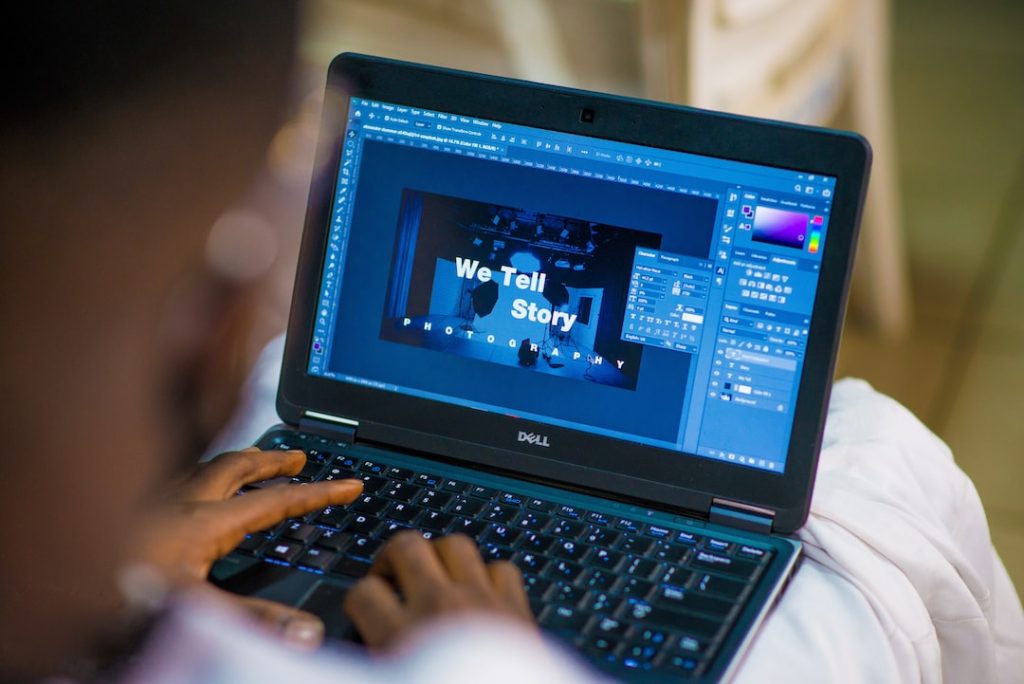Introduction: Understanding the Role of a Graphic Designer
Graphic design is a creative field that involves the visual communication of ideas and messages through various mediums. It is the art of combining text, images, and other elements to create visually appealing designs that effectively convey a specific message or evoke a desired response. Graphic design plays a crucial role in various industries, including advertising, marketing, web design, and print media. It is a powerful tool that helps businesses and individuals communicate their brand identity, promote their products or services, and engage with their target audience.
To become a successful graphic designer, one must possess a combination of artistic and technical skills. Creativity is essential, as designers need to come up with unique and innovative ideas that stand out from the competition. They must also have a strong understanding of design principles, such as composition, colour theory, and typography. Additionally, proficiency in digital design software is crucial, as most design work is done on computers. Good communication and problem-solving skills are also important, as designers often work closely with clients and need to understand their needs and goals.
The Initial Brief: Gathering Information and Ideas
Before starting any design project, it is essential to gather information and ideas from the client. This initial brief helps designers understand the client’s needs, goals, and expectations for the project. It is crucial to have a clear understanding of what the client wants to achieve with the design, as this will guide the entire design process.
In addition to understanding the client’s needs, designers must also research the target audience and competition. This involves studying the demographics, preferences, and behaviours of the target audience to create designs that resonate with them. It is also important to analyze the competition to ensure that the design stands out and offers a unique value proposition.
Brainstorming and ideation techniques are also crucial in the initial stages of the design process. This involves generating a wide range of ideas and concepts that can be explored further. Techniques such as mind mapping, sketching, and word association can help designers come up with creative and innovative solutions. The goal is to generate as many ideas as possible and then narrow down the options based on the client’s needs and goals.
Sketching: Bringing Ideas to Life on Paper
Sketching is an essential part of the design process, as it allows designers to bring their ideas to life on paper. It is a quick and effective way to explore different design concepts and layouts before moving on to the digital stage. Sketching helps designers visualize their ideas and make adjustments or improvements before investing time and effort into creating digital designs.
There are different sketching techniques that designers can use, depending on their preferences and the project requirements. Some designers prefer to sketch with pencil and paper, while others use digital tablets or sketching software. The important thing is to find a technique that works best for the individual designer and allows them to express their ideas effectively.
Tips for effective sketching include starting with rough and loose sketches to explore different ideas, using simple shapes and lines to represent elements, and focusing on the overall composition and layout rather than details. It is also important to experiment with different perspectives, angles, and arrangements to find the most visually appealing and impactful design.
Digital Tools: Transferring Sketches to the Computer
Once the initial sketches are complete, it is time to transfer them to the computer using digital design software. There are various software options available, each with its own features and capabilities. It is important to choose the right software for the project based on its requirements and the designer’s familiarity and proficiency with the software.
Some popular digital design software options include Adobe Photoshop, Adobe Illustrator, and Sketch. Photoshop is primarily used for editing and manipulating images, while Illustrator is more focused on creating vector-based graphics. Sketch is a popular choice for web and user interface design. Each software has its own learning curve, so it is important to invest time in learning and mastering the chosen software.
Tips for using digital tools effectively include organizing files and layers to keep the design process organized, using shortcuts and hotkeys to speed up workflow, and experimenting with different tools and effects to achieve the desired look and feel. It is also important to save files in the appropriate formats and resolutions for the intended use, whether it is for print or digital release.
Colour Theory: Choosing the Right Colours for the Design
Colour plays a crucial role in graphic design, as it can evoke emotions, convey messages, and create visual interest. Understanding colour psychology and how different colours are perceived by the audience is essential in choosing the right colours for a design.
Colour theory involves understanding the relationships between colours and how they interact with each other. This includes learning about colour schemes, such as complementary, analogous, and monochromatic, and how to create harmonious colour combinations. It is important to choose colours that not only look visually appealing but also align with the brand identity and message of the design.
Tips for selecting the right colours for a project include considering the target audience and their preferences, using colour palettes and swatches to create a cohesive look, and experimenting with different colour combinations to find the most effective one. It is also important to consider the context in which the design will be used, as colours can have different meanings and associations in different cultures and industries.
Typography: Selecting the Best Fonts for the Project
Typography is the art of arranging and selecting fonts to enhance the readability and visual appeal of a design. It plays a crucial role in graphic design, as the choice of fonts can greatly impact the overall look and feel of a design.
There are different font categories and styles to choose from, including serif, sans-serif, script, and display fonts. Each font has its own personality and conveys a different message. It is important to choose fonts that not only look visually appealing but also align with the brand identity and message of the design.
Tips for choosing the right fonts for a project include considering the target audience and their preferences, using a combination of fonts to create visual interest and hierarchy, and ensuring that the fonts are legible and readable at different sizes. It is also important to consider the context in which the design will be used, as certain fonts may be more appropriate for specific industries or purposes.
Layout and Composition: Arranging Elements for Maximum Impact
Layout and composition are crucial in graphic design, as they determine how the elements are arranged and organized within a design. Effective layout and composition can greatly enhance the visual impact and readability of a design.
There are principles of layout and composition that designers can follow to create visually appealing and balanced designs. These principles include balance, alignment, proximity, contrast, and repetition. By applying these principles, designers can create a visual hierarchy that guides the viewer’s eye and emphasizes the most important elements of the design.
Tips for effective layout and composition include using grids and guides to align and organize elements, experimenting with different arrangements and placements to find the most visually appealing composition, and considering the negative space or white space to create a balanced and harmonious design. It is also important to consider the medium in which the design will be used, as different mediums may have different layout requirements.
Revisions and Feedback: Collaborating with Clients and Peers
The design process is not a linear path, but rather a collaborative and iterative process that involves feedback and revisions. Feedback is crucial in the design process, as it helps designers refine and improve their designs based on the client’s needs and goals.
When giving feedback, it is important to be specific and constructive. Instead of simply saying “I don’t like it,” provide specific reasons and suggestions for improvement. When receiving feedback, it is important to listen and consider the feedback objectively, without taking it personally. It is also important to ask clarifying questions and seek further input if needed.
Strategies for incorporating feedback into the design include analyzing the feedback and identifying common themes or patterns, making revisions based on the feedback while still staying true to the original vision, and seeking additional feedback or opinions if needed. It is important to remember that the design is ultimately for the client or target audience, so their feedback should be taken into consideration.
Finalising the Design: Preparing for Print or Digital Release
Once the design has gone through several rounds of revisions and feedback, it is time to finalize the design and prepare it for print or digital release. This involves ensuring that all the elements are in place, the design is visually appealing and balanced, and the files are ready for the intended use.
The finalization process includes checking for any errors or inconsistencies, such as spelling mistakes or incorrect colours. It also involves preparing the files in the appropriate formats and resolutions for the intended use, whether it is for print or digital release. It is important to follow the specifications and guidelines provided by the printer or digital platform to ensure that the design is displayed or printed correctly.
Tips for ensuring the design is ready for release include conducting a final quality check to ensure that all elements are in place and there are no errors, saving files in the appropriate formats and resolutions, and creating backups of the files for future reference or revisions. It is also important to communicate with the printer or digital platform to ensure that they have all the necessary files and information for the release.
Reflection: Learning from the Creative Process and Improving Future Projects
Reflection is an important part of the design process, as it allows designers to learn from their experiences and improve their future projects. By reflecting on the design process, designers can identify what worked well and what could be improved, and apply these insights to future projects.
Importance of reflection in the design process includes gaining a deeper understanding of one’s strengths and weaknesses as a designer, identifying areas for improvement and growth, and learning from both successes and failures. It is important to take the time to reflect on each project and evaluate its success based on the client’s goals and objectives.
Strategies for improving future projects include seeking feedback and input from peers and mentors, staying up to date with the latest design trends and techniques, and continuously learning and growing as a designer. It is important to embrace a growth mindset and be open to new ideas and perspectives.
Conclusion:
The design process is a complex and iterative journey that involves various stages and skills. Each step in the process, from understanding the client’s needs to finalizing the design, plays a crucial role in creating effective and impactful designs. By following the design process and continuously learning and growing as a designer, one can create designs that not only meet the client’s goals but also engage and resonate with the target audience.

